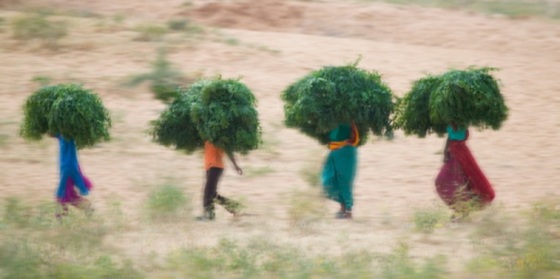Shall I not have intelligence with the earth?
Am I not partly leaves and vegetable mould myself?
~ Thoreau
Ayurveda: The Art of Living Wisely
By Laura Plumb
The ancient science of Ayurveda is really the art of living wisely, as it empowers people to make choices that nurture and sustain balance, wellness, and vitality. Ayurveda is a nature-based approach to healing that recognizes the unique difference of every individual ~ and, because every one of us is unique, every illness is unique; so, no disease, even if it goes by the same name, can be alike. Therefore, in Ayurveda, we seek to treat not the disease, nor the symptoms of the disease, but the person, the whole person, by attempting to dissolve the underlying cause of suffering and re-establish the fundamental state of wellbeing.

While it is a very personalized system of medicine, there are simple, intuitive and universal guidelines for healthy living. The first principle behind Ayurveda as it relates to food is to eat nature. That may sound simple but walk into an ordinary grocery store and you will be hard-pressed to find real food – i.e., food that is grown by the forces of sun, soil, wind and water. So, start by eating nature’s produce, as fresh and as close to the source as possible so that it retains its living intelligence and energy, what we call Prana or life force.
Look to “eat nature” then, as close to its source as possible. When you eat food that is locally grown, you benefit from the intelligence in nature that sustains seasonal balance. For instance, in Autumn we harvest root vegetables which help build our strength and immunity for winter. In the Spring, bitter and pungent greens sprout to help us detoxify and lighten winter’s load. So the second principle is to eat according to the seasons.
A third principle and important general rule it is to maintain a strong Agni. Agni, meaning digestive fire, is the Sanskrit root for our word ignite. For optimal health you have to have optimal fire in the belly. Heavy foods, too much food, cold food, old food, frozen, canned or processed food, even cold water taken with your meal, contribute to reducing the digestive fire.
Imagine the digestive system as a large fire. If you add too much wood, say Thanksgiving feast, then you will put the fire out. If the wood is too wet, too heavy, or too hard you are likely to extinguish the flame. And if you add artificial materials, as most “food” is these days, you will certainly reduce the flames – or, at least, create a lot of toxic smoke.
If you feel heavy, lethargic, dull-minded, or you are experiencing mood swings, then you may have a low-burning fire that has resulted in a toxic build-up that in turn is making your whole system sluggishness. To strengthen your digestive fire, try fasting to clear any clogging, sticky toxins. You can simply skip dinner one night weekly, or stick to a liquid diet for a few days. Sipping warm vegetable soups and broths for your three meals not only detoxifies, it fans the abdominal flames.
Drinking lemon and ginger tea throughout the day, and always with your meals, will increase digestive fire and help reduce Ama. Add ginger to your food, too, when cooking. Try to eat fresh, home-cooked meals as much as possible, and consider working with me as your Ayurvedic practitioner to teach you how to eat right for your mind-body type, or click here to take my Dosha Quiz.
Nature gives us exactly what we need. For this, we bless our food. We give thanks for the nourishment. Let’s remember that food is what we are made of. Your next breakfast, lunch, dinner will soon become a nerve, a muscle, a brain cell, or energy. It is a miracle, and you are a part of that miracle. Ayurveda is the reminder of that truth: You are a miracle living in a miraculous world!
Ultimately there is no end to this elegant, natural and synergistic method of healing. It continues to unfold inner potential, inner intelligence and inner power that motivates and encourages us to greater and greater self-expression. Through Ayurveda we become the master of our own lives, living its wisdom artfully.
If you would like to learn what Ayurveda can do for you, please email me: lauraplumb@san.rr.com or visit my website.
Copyright: This article is my intellectual property. If you would like to reprint it, please contact me for permission. Thank you!





Dear Laura,
This blossoming on-line love story of yours weaves such a glorious web of food, spice, wisdom, nature, season, camaraderie, creativity, celebration and of course, love! I adore how you mix recipes with Ayurvedic philosophy, Yogic truths and personal story.
I have devoured your words voraciously while caught in the white drifts of a snow storm in the Sierra Nevadas, and they warm me thoroughly. I especially look forward to learning more about the six tastes and how we can transform food into a daily infusion of vitality and joy, as you so graciously model.
Namaste, bon appetit and love,
Rebecca
Spot On Rebecca. Laura has beautifully captured the wisdom of Ayurveda
Darling Rebecca,
You take my breath away.
Enjoy snow drifts and love and come back soon.
Laura
Laura~
I am a great foodie and fall in love even more as I add Ayurvedic principles and wisdom to the food I create. Thank you so much for your dedication to all things beautiful. I hope to cook with you someday and create a feast infused with love!
Love all ways- in light
Dawna
Thanks Dawna Love! You are wonderful.
Yay!!
I just put that quote in my book!
Pingback: Cilantro Miso Sauce~ « Nourishing Roots
Pingback: Spring Detox ~ The Hanuman Challenge | Laura Plumb
Pingback: Spring Detox ~ The Shiva Challenge | Laura Plumb
Pingback: Spring Detox ~ The Vishnu Challenge | Laura Plumb
Pingback: Balance is Wellness for Women | Laura Plumb
This is awesome! It is right in line with where I am at in this journey! I love yoga and do it often. Recently, I’ve began studying the Chakra’s and stones.
It is a great balance to the strength training. I love your spirit!
wonderful. Thank you!
Thank you, Nick!
I love all your posts about healthy living, especially the focus on Ayurveda. I would love to become more educated on Ayurvedic food and living. I just started a blog on healthy livng and plan to share some of my newfound knowledge there. Your site is very inspiring to me!
http://www.bloomandspark.wordpress.com
Thank you, Carolyn. Your new blog is inspiring. Good luck with it!
According to the Charaka Samhita meat is the most nourishing food for a human being. It astounds me that so many “Ayurvedic” practicioners choose to completely ignore such a huge section of what is a fundamental text on Ayurveda by leaving out any references to meat.
Thank you CJ! I understand that and do counsel clients accordingly. It may be that many practitioners don’t eat or reference meat because so many of us are Yogis, while so many traditional Vaidyas are Brahmins.
It’s an important clarification, one which I think the respected Dr Partap Chauhan of the Jiva Ayurvedic Research Institute explains well in this article, http://www.nchtuk.org/index.php/tutorials-mainmenu-48/2013-02-22-17-41-14/ayurveda-veg-or-non-veg
If you are a practitioner, I’d love to hear more from you on your clinical approach and experience.
Thanks!
Laura, thanks for the link to Dr. Chauhan’s article. A very useful bit of information for one who has embraced a vegetarian diet. It all comes down to sattvic practices, what is most natural, and balance. Happy day!
Very Impressive and good blog!! Thanks for sharing..
Thank you Anubhav!
Great blog. Thank you so much Laura for presenting the importance of Ayurveda with amazing pictures. Once again thanks for this and please share something about Ayurveda. I also want to know more information related to this topic.
Thanks Shenika. What specifically would you like to know?
Thanks for the tips!
Very Very useful and well informed. I hope I will write like you someday. Keep writing.
good article and thanks for the tips . i have taken ayurveda treatments at sanjeevanam ayurveda hospital in kerala and i can definetely say that what you have written is true and correct